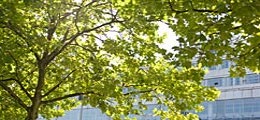CeBiTec Colloquium (unscheduled)
| date |
Tuesday, December 11th 2012,17 c.t. |
|
| location |
G2-104, CeBiTec Building |
|
| speaker |
Prof. Dr. John GolbeckPenn State Department of Chemistry - Pennsylvania State University, USA |
|
| title |
A Solar Hydrogen-Producing Bio-Nanoconstruct that outperforms Natural Photosynthesis |
|
| abstract |
The photosynthetic efficiency for solar conversion of H2O and NADP+ to O2 and NADPH is 11.8%. In contrast, the highest reported photosynthetic efficiency for solar conversion to biomass is 2.4% for C3 plants and 3.7% for C4 plants. Thus, there exist large downstream metabolic losses between the most immediate product of photosynthesis and a harvestable product. We asked whether it might be possible to increase the efficiency of solar to biofuel production by directly wiring a protein catalyst to the reaction center. The strategy used here employs a molecular wire to directly connect the redox centers of Photosystem I (PSI) and a protein catalyst such as a H2ase enzyme. The molecular wire serves to tether the photochemical module to the catalytic module at a fixed distance so that the electron can quantum mechanically tunnel between the surface-located [4Fe-4S] clusters of PSI and a H2ase at a rate faster than the competing charge recombination between P700+ and FB–. The PSI—wire—[FeFe]-H2ase bioconstruct evolves H2 at a rate of 2850 µmoles mg Chl-1 h-1, which is an electron transfer throughput of 5700 µmoles mg Chl-1 h-1, or 142 µmoles e– PSI-1 s-1. Putting this into perspective, cyanobacteria evolve O2 at a rate of ~400 µmoles mg Chl-1 h-1, which is an electron transfer throughput of 1600 µmoles mg Chl-1 h-1, or 49 e– PSI-1 s-1, given a PSI to PSII ratio of 1.8 as in Synechococcus sp. PCC 7002. Hence, the bioconstruct outperforms natural photosynthesis by a factor of 3.5, an increase due entirely to the elimination of kinetic bottlenecks due to diffusion chemistry. In this talk, I will discuss potential solutions to increasing the efficiency of solar biofuels production by taking advantage of direct wiring of protein catalysts, including formic acid dehydrogenase, to Photosystem I.
|
|
| host |
Prof. Dr. Olaf Kruse |



